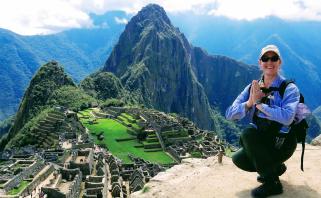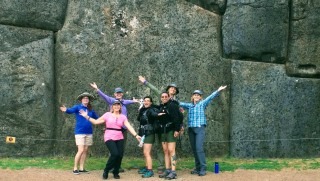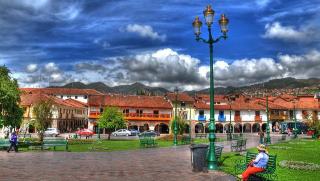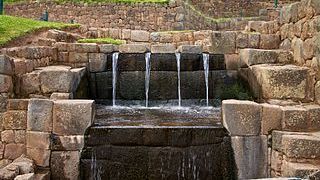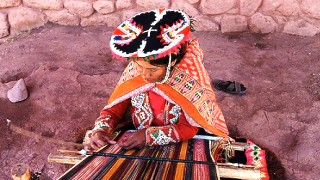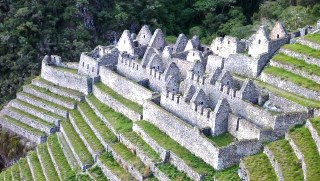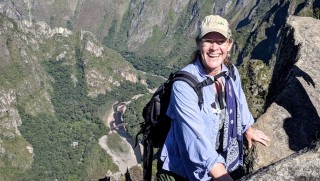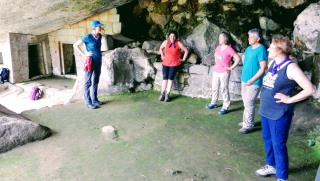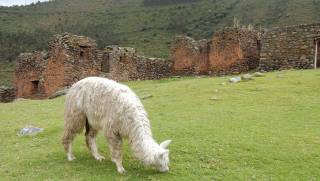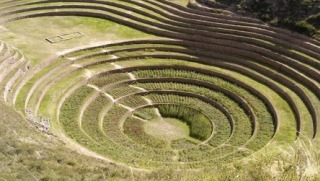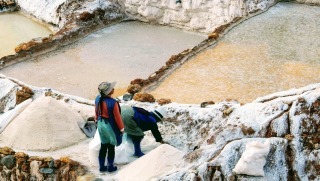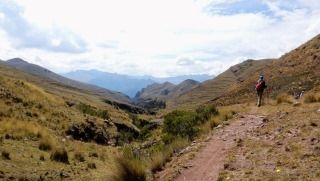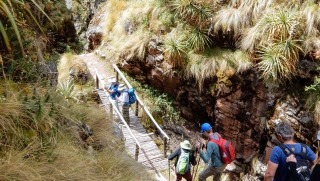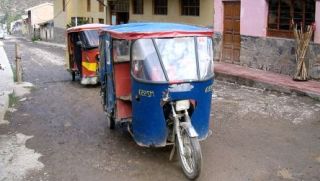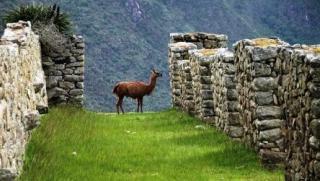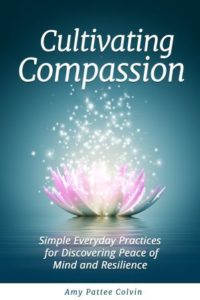A Peru meditation retreat that focuses on Machu Picchu and the Sacred Valley, offers a vast array of experiences for open-hearted, curious travelers looking for a spiritual adventure.
Landscapes range from humid jungles to high mountain passes. Architectural and spiritual history intertwine with current cultures, and masterfully built Incan ruins seem to sprout from the earth.
At the height of its power, the Inca Empire stretched nearly 2,500 miles along the South American coast, encompassing territory in present-day Ecuador, Peru, Bolivia, Chile, Argentina and even sections of Colombia. The Inca civilization expanded exponentially from 1200 to 1400 AD and ended suddenly in 1532 when Francisco Pizarro and his fellow Spaniards invaded.
However, during its reign, the Inca Empire achieved masterful feats of infrastructure and architecture, including fourteen-thousand miles of trails that linked one side of the empire to the other, the precise construction of buildings sturdy to remain standing today, and the formation of a unifying religion and language utilized by more than ten-million subjects.
Travelers often visit Peru to visit Machu Picchu, but many find their most vibrant memories are of the people, culture, and landscapes. Here are a few reasons to consider adding a Peru meditation retreat to your wish list.
1. Stand in Awe of Ancient Architecture at Sacsayhuaman
The ruins at Sacsayhuaman are some of the most amazing in the world. Construction of this fortress on a high plateau began during the reign of Inca Pachacutec in the fifteenth century. Research suggests that more than twenty-thousand men extracted the stones from quarries twenty kilometers away, carving them onsite and then transporting these giant stones to the hill above the city of Cusco.
They then fit these perfectly cut stones together like a giant jigsaw puzzle, leaving nearly no gap between them.
Current estimates suggest that today Sacsayhuaman retains 40 percent of its original structure. Yet some existing stones weigh over 125 tons. How did the Incas build Sacsayhuaman and similar structures with the copper and stone tools available at the time? The answer remains a mystery.
2. Explore Cusco, a UNESCO Heritage Site
Nestled in the Peruvian Andes, Cusco emerged under the Inca ruler Pachacutec into a complex urban center with distinct administrative and religious sections. Outside the central city lay areas for industry, agriculture, and artistry.
The Spaniards conquered Cusco in the 16th century, but they preserved the basic urban structure and built palaces and churches over the Incan ruins, integrating the existing architecture into their own.
Cusco sits at just over 11,000 feet, and you may notice mild symptoms of altitude sickness. Be content to explore slowly, drink plenty of water, and avoid alcohol in excess. Places to visit include the San Blas area of hilly scenic streets and the main town square, Plaza de Armas. Also worth a visit is Qorikiancha, the most important temple in the Incan empire and served as the foundation for the Convent of Santo Domingo, built by the Spanish in the seventeenth century.
3. Travel to Tipón
Tipón is a rarely visited archeological site constructed in the early fifteenth century, most likely as an imperial estate for the Inca elite.
The site may have been ceremonial, or it may have served as an architectural laboratory due to the various micro-climates within the site and the reliable year-round water flow.
Precise and right-angled terraces are clearly visible at this site, and a natural spring feeds an irrigation network of canals and fountains that still flow today. The design of this site illustrates that the Incas were excellent hydraulic engineers.
Harmonizing with the energy here, and perhaps practicing some qigong is a wonderful aspect of attending a Peru meditation retreat.
4. Engage With Past and Present Culture at Chinchero
On the high windswept Andean plains is a small village named Chinchero that offers beautiful views over the Sacred Valley and the snow-capped peak of Salkantay.
In Incan mythology, Chinchero is believed to be the birthplace of the rainbow, and certainly, its local and famous weavers integrate rich colors into their wares and traditional dress.
Taking in a weaving demonstration at one of the weaver co-operatives is a beautiful way to deepen your understanding of traditional culture. If you’d like to purchase Peruvian textiles, Chinchero is an excellent place to do so.
Archeologically, the site is attributed to Inca Tupac Yupanqui, who possibly used Chinchero as a country resort. Some of the agricultural terraces and aqueducts are still in use. You’ll find wonderful displays of Inca stonework throughout the site, including what was once a stone throne decorated with carvings.
As you look down the valley from the terraces, you’ll see an immense boulder, reached by an easy walk on an ancient Inca trail. The boulder has a staircase carved into it to reach the top, which consists of a maze of carved spaces. Carvings also represent the Inca spiritual trilogy—the serpent, the puma, and the condor.
5. Do a One Day Hike of the Inca Trail to Machu Picchu
The Inca Trail is one of the world’s best multi-day hikes, taking four days to walk the entire trail, ending in Machu Picchu. Fortunately, a one-day option is available! You’ll need to be in moderate to excellent physical condition to enjoy this hike.
Board the train in Ollantaytambo, bound for the town of Aguas Calientes, then disembark the train at distance marker 104.
The day hike, the final section of what is traditionally known as the Inca Trail, takes you along the Urubamba River valley as you climb up onto the mountainside—with a total elevation gain of about 1,700 feet.
You’ll find gorgeous mountain views, lush and diverse vegetation throughout the journey, and exquisite Inca ruins, including Chachabamba and Wiñay Wayna. An hour or so after exploring these ruins, you’ll arrive at the Sun Gate, where you’ll have your first view of Machu Picchu!
You’ll descend from the Sun Gate into the central Machu Picchu citadel and learn about its extraordinary history. Depending on the timing of your day, you may witness sunset at the ruins, a time with fewer tourists.
6. Explore Huayna Picchu and Temple of the Moon Cave
Huayna Picchu is the sharp peak at the edge of the Macchu Picchu citadel, and it is often featured in photos of the area. Hiking up the scenic trail leads you on stone stairways built by the Inca empire up a jungle-covered mountainside.
The hike is challenging but not technical and is appropriate for people with moderate or better fitness.
Despite the challenging terrain, this trail is in high demand, and only 400 hikers per day receive permits, so plan to book months in advance to reserve a spot.
As you start, you’ll have views of the Urubamba river, Putucusi mountain, and an array of dramatic green peaks in the distance. The hike itself is an uphill trek—sometimes shady and sometimes sunny as you move through switchbacks—on time-worn Inca stone stairways.
After half an hour or so of hiking, you’ll have your first views of the Machu Picchu citadel in the distance, highlighting the elevation you’ve gained. From here, the stairway is steeper and more narrow, and a steel cable handrail is available for balance. In this section of the trail, you’ll first encounter Inca terraces and buildings, which some say were once inhabited by Inca priests.
The last push to the summit requires climbing a final stone staircase. Though the drop-offs are steep, the path is wide, and the views are spectacular. Take your time and enjoy the experience!
Once you pass the last stone stairway, the summit of Huayna Picchu mountain is only a short distance away.
Soak in the views of the Machu Picchu citadel and the zigzag switchbacks of the road leading down to the Urubamba River and the town of Aguas Calientes. After basking in the views at the summit of Huayna Picchu mountain, leave the viewpoint and watch for a spur trail that sweeps around the backside of the mountain.
This path leads to the Temple of the Moon, an ancient ceremonial temple inside a cave. This awe-inspiring cave temple is not always open to hikers, but it is well worth visiting if you are able. If you’d like to make this detour, allow yourself an extra two to three hours of total hiking time.
7. Visit the Pre-Inca Ruins of Pumamarca
The rarely-visited Pumamarca ruins, away from the typical tourist trail, offer an opportunity to experience a slice of history peacefully and tranquilly.
The Wari civilization—pre-Inca—built this hillside fortress to guard an entrance to the Sacred Valley.
A network of ancient paths still leads to and from this site built on a steep slope above the convergence of the Yuracamayo river and Río Patachancha.
Eventually, the Inca overtook the Wari culture, and this site was likely used for ceremonies. It once again became a fortress during the Spanish invasion offering panoramic views over the valley below. Inside the fortress walls, the old village is in good shape, and you’ll find dwellings, granaries, and temples.
After exploring the site, you can walk back to the town of Ollantaytambo via an Inca trail. The walk takes about three hours at a gentle pace and offers views of Patachancha Valley, Inca terraces, and Inca aqueducts. Local farmers still use the terraces and irrigation system to produce potatoes, quinoa, corn and many other vegetables and fruit.
The ruins and the subsequent walk help you embody a connection to the past. What you witness today—flowing water, growing crops, community, and dramatic mountain landscapes—is not much different from thousands of years ago.
8. Wonder at the Circles of Moray
Moray is another Inca ruin in the Sacred Valley. The deep, circular terraced hollows are reminiscent of a Roman amphitheater.
The intention behind the development of these concentric terraces is still a mystery. However, a promising theory is that the ruins were once an Inca agricultural laboratory.
The terraces’ design, depth, and orientation to the sun and wind suggest they were built for a specific purpose. Based on elevation in relation to its neighbor, each terrace leads to temperature variances—ranging a full 27°F from top to bottom. The microclimates at each level allowed the Inca to study and modify wild vegetation creating crops suitable for human consumption.
Inca agriculturalists had excellent scientific and analytic thinking skills. They worked extensively with potato varieties, and now Peru is famous for its over two-thousand variations of potato. Also, studies show that the soil in Moray comes from various regions throughout Peru. The importation of soil supports the suggestion that Moray was an experimentation center. Inca engineering is also evident as these terraces never flood, even during the rainy season. A network of engineered channels permits the water to drain effectively.
9. View Maras Salt Flats
Few places on earth still function as originally designed hundreds of years ago. The Maras Salt Mines, also known as the Maras Salt Flats, is an ancient site first used by the pre-Inca Chanapata culture.
For over 500 years, salt has been harvested daily from ponds carved into the mountainside.
Today, approximately 4,500 salt pans remain, each owned and harvested by a family, and each family participates in a collective to preserve their rights. The ponds vary in size based on the needs of the family who owns them.
The flats, fed by an ancient spring sourced from a prehistoric lake flow through a maze of canals to reach each well. Canals that feed each pan are opened and closed as desired, creating the opportunity to fill the pan, let it dry through evaporation, harvest the remaining salt, and refill it.
The pans themselves appear as a massive, human-created mosaic. Some are wet with a shiny surface; others are dry with piles of pinkish-white salt ready for bagging. The salt, coveted for its healing properties similar to those associated with the Dead Sea salt, has a delicate flavor.
10. Cross a Remote Andean Pass, and Visit Huchuy Qosqo Ruins
This is a gorgeous full-day hike, about 11 miles, through the Andes. As you begin, you wander up a U-shaped valley toward the head of a cirque.
You’ll see traces of ancient Inca footpaths, terraces, and aqueducts, and you’ll encounter few travelers but may see a few herders with wild horses or locals mule-packing supplies to their alpine homes.
After passing a beautiful tarn, you’ll climb more steeply toward the pass, gaining about 2,000 feet from the start of your walk. Take your time and enjoy the scenery. At the top of the pass, 14,410 feet, you’ll see a cairn, the view opens up, and you’ll see snow-capped peaks in the distance. Spread below you is a broad, gently sloping steppe that heads down into a few small villages.
After descending the arid grass-covered slope, you’ll reach a section of trail that drops steeply into a canyon whose walls are dotted with tropical-looking plants. This narrow canyon is truly spectacular.
You’re following an Inca stone path, and a stream with waterfalls cascades down the path beside you.
Around you is a vast array of plants, and birdsong echos off the canyon walls. The humid warmth of the canyon, contrasting with the windy steppes above, is astounding.
After dropping down the canyon for an hour or so, the trail flattens once again, and you traverse across a hillside toward the Huchuy Qosqo ruins, likely built by the eighth Incan Ruler, Viracocha. The preservation of these ruins is remarkable, and the views of the Vilcabamba mountain range are spectacular.
After relaxing and enjoying the ruins, you’ll embark on the final leg of the journey—a long steep switchback trail down to the town of Lamay. This is an excellent place to have hiking poles! At the end of the day, reflect on all you’ve seen and how few other travelers you encounter. You crossed a 14,000+ foot pass, walked on Inca footpaths, traveled broad grassy steppes and a narrow slot canyon, and visited a well-preserved ruin—quite an accomplishment!
11. Enjoy a Day in the Life of Urubamba
One of the most delightful aspects of traveling to Peru is spending time with friendly and warm local people. Opportunities to engage with local culture are widely available in Urubamba. Traveling by moto-taxi is an excellent way to get across town.
Perhaps you’ll have a cooking lesson complete with a visit to the local market. Learn and help prepare traditional Peruvian dishes.
Another option for enjoying local culture is visiting a chicha brewer. Chicha is a popular beverage in Peru made from fermented purple corn. You’ll have an opportunity to learn how this traditional drink is made as well as a chance to taste it.
You may also choose to visit an artisanal chocolatier. You’ll learn how to roast cacao beans, husk them, grind them and turn the subsequent chocolate paste into chocolate bars. You may even have a chance to sip some deliciously rich hot chocolate from the beans you just husked.
12. Visit the Pisac Ruins
The town is Pisac is a serene rural village 20 miles from Cusco. The town center has a vibrant market, but one of the most enchanting reasons to visit is the ruins found at the National Archeological Park of Pisac.
The ruins here are among Peru’s most extensive archeological sites in the Sacred Valley of the Incas.
Inca architecture was customarily built in the shape of animals, and Pisac is shaped like a partridge, thus its name. The ruins at Pisac include numerous archeological divisions, including cemeteries, aqueducts, bridges, platforms, palaces, walls, towers, and terraces. The masonry fits together so well no mortar was needed.
The ruins are grouped into four “neighborhoods,” with the most intriguing being the ceremonial center known as the Sun Temple. It is accessed through Amaru Punku, the Serpent Door, which once served as a guard post to prevent invaders from accessing the site. Once through the door, you pass through a sixteen-foot tunnel hollowed from the rock.
Then you arrive at the ceremonial center—the Sun Temple—a marvel of Inca stonemasonry. Carved largely of pink granite, the temple features a beautiful example of an intihuatana, a sundial used by Inca priests to chart the movements of the heavens and predict the solstices and equinoxes.
At Pisac, the intihuatana is carved directly into the rock and surrounded by a D-shaped temple, oriented to align perfectly with the sun on the June solstice. The Sun Temple also contains an altar for animal sacrifices and a ceremonial fount that still bubbles water today. Nearby, a three-tiered symbol alludes to Inca cosmology’s three worlds—heaven, earth, and the underworld.
Join me for a Peru meditation retreat!
Now that your interest is piqued join me for a spiritual adventure tour to Peru. You’ll have an opportunity to experience all of the above highlights firsthand and have a chance to meditate and practice qigong daily. We’ll also have invigorating and inspirational conversations on how to cultivate compassion, enhance inner peace, and tap into vitality.
Enjoy a heart-opening spiritual journey to the beautiful natural sites of this rich and varied land, and make real connections with local people. You’ll return home with inspiring travel memories that capture Peru’s diverse and unique essence and its ancient traditions, cultures, and spiritual life.
A great vacation can be life-changing, but returning home refreshed and rejuvenated takes a unique blend of creativity and precision, as well as a commitment to honoring your higher self. You and your well-being are worth the investment.
Explore this website for further information, or please contact me with any questions. I’d love to have you join me for an upcoming spiritual tour.

